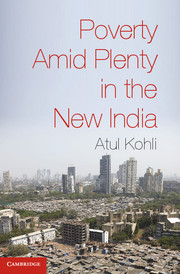Conclusion
Published online by Cambridge University Press: 05 June 2012
Summary
India's economy is growing briskly, but many Indians are being left behind. The democratic promise of inclusive growth is not being met. This study has sought both to focus attention on this fact and to explain why it might be so. The facts of the situation are relatively clear. India's economy has grown handsomely since about 1980, and the growth rate is now approaching that of the world's fastest-growing economy, China. Compared both to its own past and to other countries, growth acceleration in India is a major achievement. This impressive growth performance, however, has been accompanied by widening economic inequality along a variety of cleavages: rural versus urban; across Indian regions; and along class lines, especially in the cities. As the rich have gotten richer, the life chances of the poor have not improved proportionately. Poverty has declined at only a modest pace, forcing some 450 million Indians to survive on less than $1.25 per day. Literacy is also improving, but again at a fairly slow pace. Health conditions are especially abysmal: nearly half the children in the country remain underweight and anemic, and some third of Indian women suffer from low body mass index.
If the facts of want amid plenty are relatively clear, why this may be so and what can be done about it are controversial issues. One somewhat sanguine view of India's current developmental trajectory takes comfort in the fact that the Indian economy finally opened up to the world in the early 1990s and grew rapidly as a result. Since poverty and destitution in India are age-old problems, this view might continue, the new growth finally offers the possibility of incorporating the poor into a productive economy. Economic growth also generates public resources that might be used to help those at the bottom. Sooner rather than later, democratic pressures will push the rulers to use these resources constructively to provide improved education, health, and income to the majority of Indians. This is a respectable perspective on contemporary Indian development; at times I too am attracted to it, especially because of the sense of hopefulness it creates. And yet such a view is too sanguine. It is also misleading insofar as it does not take account of how deeply economic changes are embedded in political and social realities. Economic growth in India accelerated only when the ruling elite prioritized growth and slowly but surely created a narrow ruling coalition with the growth producers, commercial and business groups. More important, new economic growth is creating not only new wealth but also new power realities. New private wealth is further empowering India's business classes. These powerful groups, in turn, have begun to mold Indian politics in ways that they hope will make the Indian state even more pro-business. It is not at all obvious why such a state would prioritize distributive goals that favor the underprivileged. Electoral pressures and an occasional farsighted leader can clearly make some difference. However, systematic inclusive growth will require well-organized representation of the underprivileged in the political sphere so as to facilitate a shift, not toward populism, but toward real social-democratic politics. It will also require significant improvement in the capacity of the Indian state to deliver resources and services to the poor, a capacity woefully lacking at present.
- Type
- Chapter
- Information
- Poverty amid Plenty in the New India , pp. 212 - 228Publisher: Cambridge University PressPrint publication year: 2012



